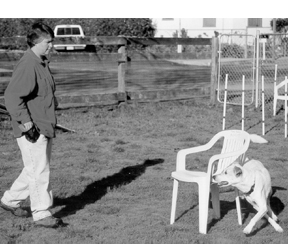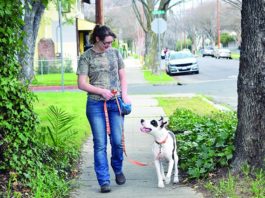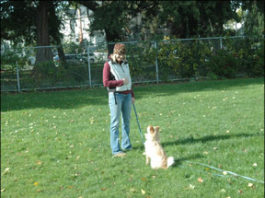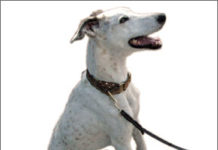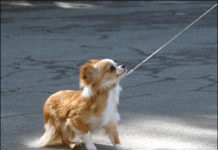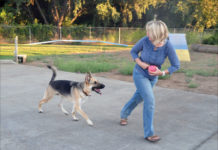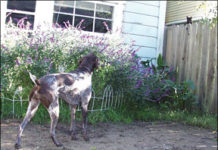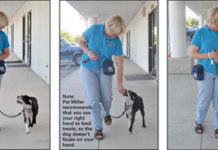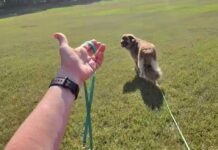A Strong Recall is Critical During Your Dog’s Water Play
No matter how strong your dog’s recall may be (and we recommend it be quite strong if you’re considering letting your dog off-leash at the beach, lake, or river), it’s important to remember that the excitement of being in the water, coupled with the potential desire to swim out for a toy or chase a flock of ducks, could result in his recall falling on deaf ears. Prior to fun water play, consider brushing up on your dog’s recall with the following...
Increase Your Dog’s Reliability
Behavior professionals often define “reliable” as responding appropriately to the cue at least 80 percent of the time. That means your dog sits at least 8 out of 10 times when you ask him to. It’s unreasonable to expect 100 percent reliability from your dog. It takes commitment to your training program to achieve reliability under a wide variety of conditions. Let’s explore some of the elements that make for true reliability.
Utilizing Target Training for Better Leash Walking
Does your dog know how to target? If not, the two of you may be missing out on one of the most versatile behaviors to come along since the rise in popularity of the positive dog training philosophy.
When Your Dog Refuses To Walk On A Leash
It’s frustrating and embarrassing when your dog puts on the brakes and refuses to move. If he’s small you can pick him up and carry him; although that might not be the best training solution, at least it gets you out of there and you can save face. But what if it’s a Great Dane, a Newfoundland, or any breed – or combination of breeds – that’s too big to be portable?
5 Things To Do If Your Dog Won’t Come to You
It's frustrating at best, dangerous at worst, when you can't get your dog to come to you. Indoors, he may be suspicious that you're going to do something aversive, such as treat his ear infection, or put him in his crate. Outdoors, he may also have an aversive association with coming to you, or he may just be having entirely too much fun. Whatever the cause, here are five tips for handling the crisis:
Train Your Dog to Stop Chasing Cats
Dogs are a predatory species. While cats think of themselves as predators, dogs often think of cats as prey. Still, many canines and felines live together in happy harmony. If yours don’t, here are some things to do when Fido chases Felix. Separate dog and cat when you’re not there to supervise. You need to protect your cat from injury or possible death, and you want to prevent your dog from practicing the unwanted chasing behavior. Depending on the intensity of the chasing behavior, you may want your cat behind a solid door when you’re away to ensure protection, or baby gates may be enough to give kitty safe zones to use as she chooses. When you are there to supervise, you still need to manage your dog so he doesn’t get reinforced for chasing the cat. Having something run away when you chase it is highly reinforcing to a dog with strong predatory behaviors.
How to Train Proper Leash Walking – Pull Over!
One of the more frustrating experiences for positive dog trainers is watching their clients being dragged by their dogs across the parking lot toward their cars, just moments after training class is dismissed. “Dang,” we sometimes think, “Will they ever teach their dogs to walk politely on-leash? What part of ‘Don’t reinforce your dog for pulling!’ didn’t they hear?” Of course, it’s equally frustrating for dog owners when their dogs drag them. And the training solution – stopping every time the dog pulls – gets tiresome.
Possible Barriers to Training Walks
Dogs who struggle to focus on their owners when away from home usually do so for one of two reasons either the dog is too distracted by the environment, or he's under the influence of anxiety or fear. With anxiety and fear, the dog's body language tells a powerful story. His posture might be slinky head low, tail tucked, ears pinned back. His pupils might be dilated, with the whites of his eyes visible.
How to Stop a Dog From Pulling on a Leash
Any chance you’d like to transform your dog walks from frustrating leash-pulling contests of strength to enjoyable and cooperative outings?
How to Get a Dog to Listen When Distracted
Does your dog respond reliably to you at home, but starts ignoring you and focusing on distractions the moment you step out the door? Getting your dog to listen when distracted starts with training in a distraction free environment and slowly adding distractions.
How to Teach a Dog to Come When Called
The goal with a recall is for the dog to respond to the “come” cue automatically, enthusiastically, and without hesitation. This is safety-critical behavior. If your dog is heading toward a busy road coming to you when you call her could save her life.
A Long Line: The Surprising Problem-Solver
The ever-changing outdoor environment is wildly exciting for our dogs. Alas, when they enthusiastically zigzag after every scent, bike, or friend, they yank us along with them. To break free, start fresh! Head to a new spot, with a different approach. Ditch the 6-footer and grab a long line, which is essentially a longer, thinner, lighter leash.


